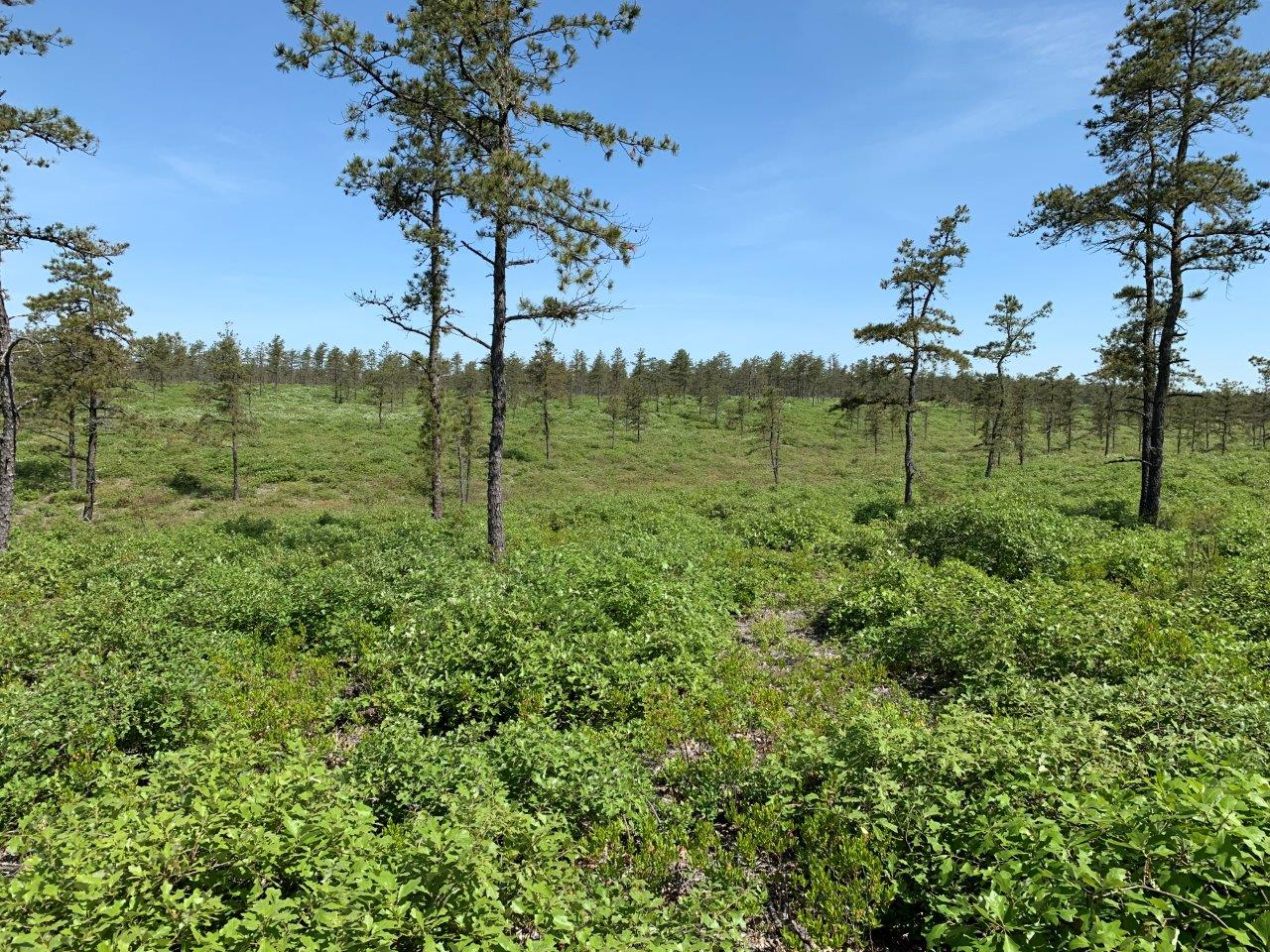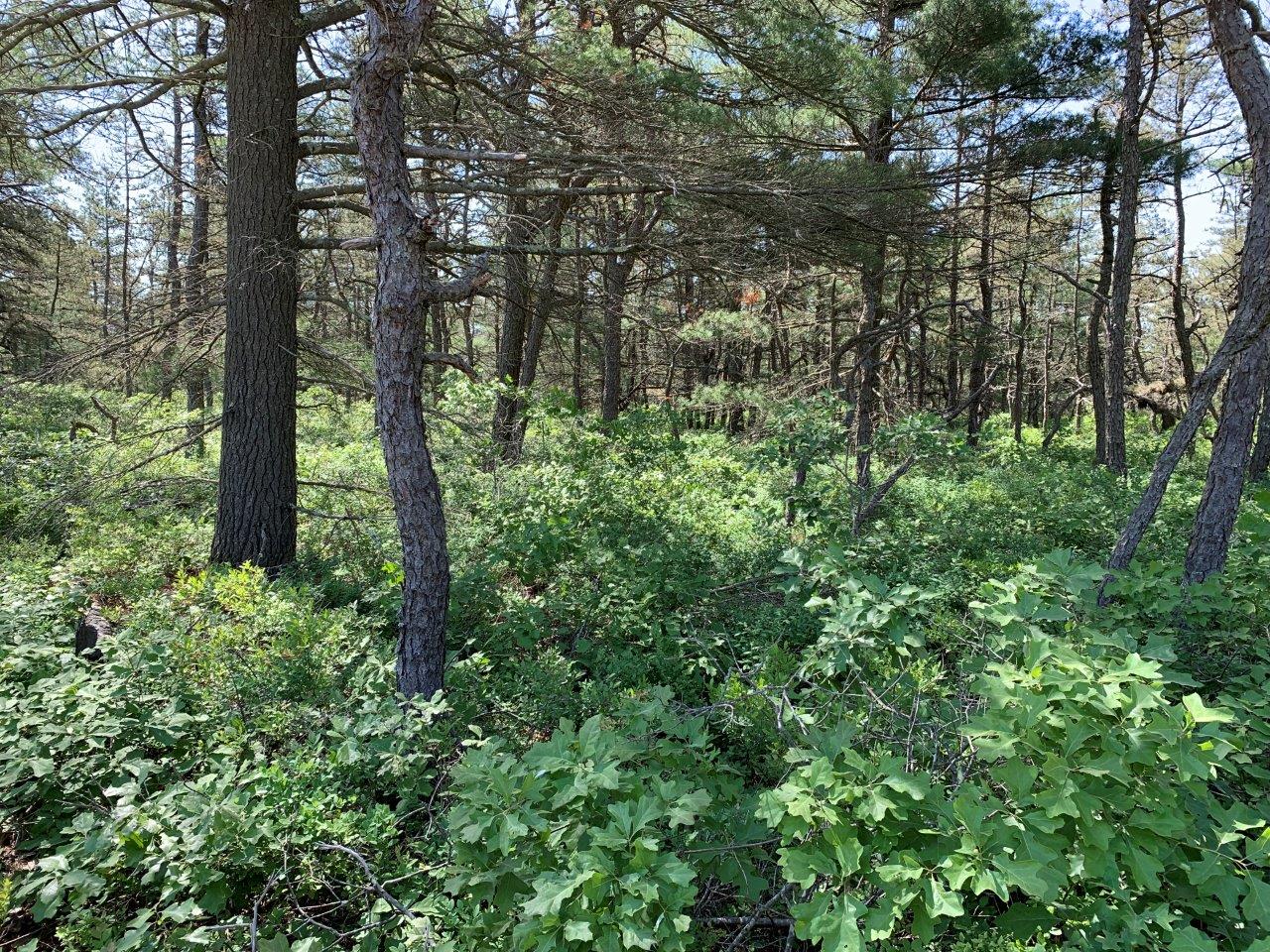Secondary tabs
Submission information
Myles Standish Complex Pine Barrens Restoration

MassWildlife and the Department of Conservation and Recreation are restoring over 2,500 acres of pitch pine and scrub oak barrens. These barrens habitats are naturally sandy and fire prone. The principal objectives of this project are to restore an open canopy pitch pine – scrub oak community to benefit state-listed butterflies & moths, native songbirds, game birds, and to mitigate the wildfire hazard associated with the current heavy fuel load conditions. Treatments have consisted of mowing small trees and shrubs in place with larger trees removed to just removing large trees. Prescribed fire has been applied to some units.
Site Location
Plymouth, Massachusetts
Myles Standish State Forest; Southeastern Pine Barrens Wildlife Management Area; Maple Springs Wildlife Management Area; and the jointly owned Camp Cachalot.
41.818836
-70.662421
Enter Myles Standish State Forest through the Cranberry Road entrance. Proceed to drive around East Head Reservoir following signs for Charge Pond Campground.
The project abuts paved roads in many places. The site can be accessed by foot through walking trails or by paved bike paths.
The Massachusetts Department of Conservation and Recreation and MassWildlife
Stand Information
2,520 acres
Pitch pine – scrub oak
Pitch Pine-Scrub Oak Barrens
early successional
southern pine beetle
southern pine beetle
Carver coarse sand and Carver loamy coarse sand
1964
Wildfire
Pre-treatment Conditions
≈ 50ft (base age 50)
As a result of colonial wood utilization (used in the making of charcoal for iron production) and wildfires, most of the forest was cleared and burnt over by the mid-1800s. Reforestation efforts began in the early 1900s and continued over the next 40 years. A roughly 6,300-acre wildfire occurred in 1964, burning most of the project area and in some cases sterilizing the soil. After the wildfire pitch pine, scrub oak, and heath species populated the project area.
Pinus rigida (pitch pine)
80%
Pinus strobus (eastern white pine)
20%
Basal area ranging from 50 to 100 sq. ft./acre
Stagnation
Silviculture Prescription
The principal objective is to complete ecological restoration of pitch pine and scrub oak natural communities. These communities are often referred to as ‘pine barrens’. This project is also designed to reduce hazardous fuel loads and thereby reduce the risk and/or spread of wildfire. Pine barrens are globally rare, fire-dependent, shrub dominated communities with scattered trees and occasional openings, occurring on dry, poor, sandy soils. They provide habitat for many rare species. Future prescribed burning will be employed to maintain these unique communities. Human effort to exclude fire in these pine barrens over the past half-century has favored the development of dense tree canopies of pitch pine and white pine and has favored the growth of white pine over pitch pine and scrub oak in some areas.
Restore and maintain native pitch pine and scrub oak natural communities with a focus on a savannah condition of individual, larger diameter, full-crowned pitch pine trees in the overstory with a dense understory of scrub oak and other native shrubs. The pitch pine-scrub oak barrens are a disturbance dependent globally rare ecosystem. This ecosystem depends on disturbance, historically fire, to maintain its open structure. To that end to sustain the function and two storied structural composition of the pine barrens, reduction in overstory density through mowing operations and/or timber harvesting followed by prescribed burns have been employed.
Ecological restoration of pitch pine and scrub oak natural communities.
Initial mowing specifications: Shrubs - All shrub cover greater than 4’ in height shall be mowed to within < 1” of the ground. Portions of the shrub canopy outside of fuel breaks that is less than 4’ tall shall be retained “as is” whenever feasible. Trees - Any/all trees 1-9” dbh not marked or otherwise identified for retention shall be mowed/mulched in place from the top down. Trees to be mulched shall not be pushed over prior to mulching (tree boles shall be mulched from the top down). Mulch specifications: mulch shall consist of shredded, non-compacted, rough-cut woody material that traps air in between individual pieces of mulch to promote drying and decomposition. Whole tree removal specifications: All white pine to be removed 1-25+” dbh. All Scots pine will be removed. All dead standing pitch pine will be removed. Pitch pine 1-9” dbh shall be removed, except in areas where larger pitch pine (10” dbh or larger) are not present. In the aforementioned areas, the contractor shall leave retention islands, groupings of 6 pitch pines 6-9” dbh (best formed and healthiest crown), every 100’. Trees within these retention islands shall be a maximum of 30’ apart. Retention islands shall only occur when there are no retained pitch pine larger than 10” dbh within 100’. All tree oaks will be retained.
The desired future condition is an open canopy of pitch pine and tree oaks above a dense understory of scrub oak, heath, and interstitial grassy glades.
fire
- threatened/endangered species
- species or ecosystem restoration
- wildlife habitat
Climate change presents new challenges for managing wildland fires in fire-adapted ecosystems. Warmer annual and seasonal temperatures, increases in drought and heat-induced tree mortality, decreases in relative humidity, and increases in fire season length are all affecting how we manage and plan for fire. Actions to alter species composition or ecosystem structure may reduce susceptibility to these threats.
By reducing the density of trees through mechanical operations and maintaining through the application of prescribed fire, we hope to create a more open forest structure that is expected to be less vulnerable to severe wildfire.
Skidder, feller buncher, flail mower, whole tree chipper, disk mower, mulching head on excavator
Initially, we were mowing small trees and shrubs followed by whole tree removal of larger trees. Currently we are only using whole tree removal as it disturbs enough of the shrubs to break up their continuity and still will be able to conduct prescribed burns.
Post-treatment
no
yes
Miscellaneous
8 to 10 years (5 years completed)
nearly 1 million dollars in State funding
Yearly treatment takes several months during the winter and spring
Maintain with prescribed fire
road construction/maintenance
Statistics
75
20
20
feet squared per acre
Contact Information
Paul Gregory & Fletcher Clark
Management Forester & Habitat Biologist
MA DCR & MassWildlife
South Carver, Massachusetts. 02366
United States
Supplementary Content
